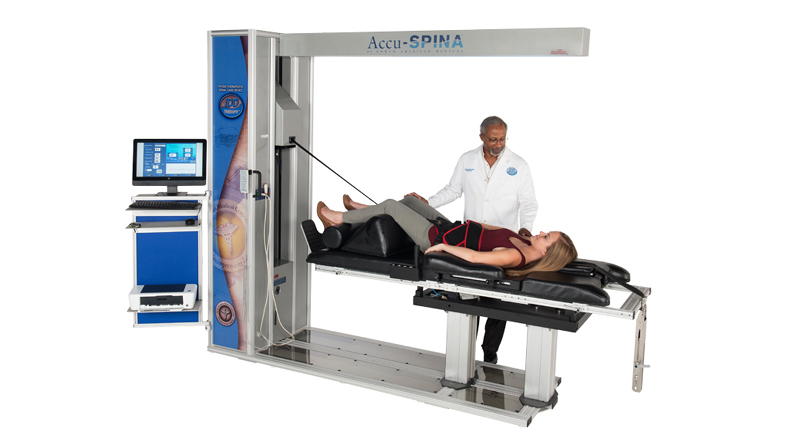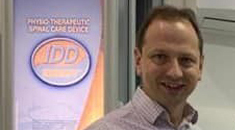BACK PAIN: IDD vs TRACTION
Traction was the popular treatment for back pain in the late 1950s and for much of the 20th century but those who remember it will know that it has been out of vogue for some time. On first impressions IDD Therapy, the fastest growing non-surgical back treatment in the UK, can appear to be a variation on the old theme.
However, there are some very important differences. Traditional traction was very imprecise. In simplistic terms, patients would be lying on an ordinary treatment couch, a traction motor would apply a basic force and clinicians would hope for some improvement.
The innovation of IDD Therapy is a day and night difference between non-specific traction and targeted decompression.
So, what are the differences between traction and IDD Therapy?
What is traction?
Traction is either a manual or mechanical therapy which uses a pulling force to either open a joint or stretch the back. Whilst manual traction of peripheral joints is straightforward with the hands, applying a longitudinal traction force to the spine is very challenging with the hands alone, because of the trunk.
Traditional mechanical traction used a mechanical pulling force, but the main problem was that it was not targeted to a specific area and the manner with which the forces were applied meant that it was often uncomfortable. Traditional mechanical traction was thus a very hit and miss affair. The results, invariably of such a random exercise were, not surprisingly, inconsistent. The unnatural pulling force of winch-like traction motors could also be uncomfortable for the body and lead to muscle spasm. Thus, forces applied would often be quite low and insufficient to achieve therapeutic objectives.
Why did traction fail and fall out of favour?
The main reason was simply that it was imprecise and thus inconsistent. Many spinal issues are found at specific levels in the back. The lumbar spine is made up of levels with intervertebral discs sandwiched between vertebrae. Each level has a label such as the L5 disc or L5S1 and many spinal issues, such as herniated discs, occur at specific levels. Without the ability to target the specific level, traditional traction could not address the specific problem and thus was rarely able to achieve positive results for such specific conditions. There is also a limit to what practitioners can achieve with their hands.
So, what is IDD Therapy and why does it work?
IDD Therapy is a complete programme of treatment and rehabilitation that is changing the way practitioners can treat unresolved back and neck pain, especially where there is a disc issue or related problem like sciatica. This mechanical spinal decompression treatment is non-surgical and non-invasive and works by decompressing and mobilising targeted spinal segments in a way that traction never could.
Combined with manual therapy and exercise, IDD Therapy helps restore spinal function, improve mobility and create a platform for long term healing. It means that for patients who might be considering pain management injections or potentially surgery, they have a realistic opportunity to get their lives back without medication or invasive interventions.
IDD Therapy isn’t very complicated. There is some physics to the method because distraction forces are applied at specific angles. This is based on vector forces and by changing the angle at which the force is applied, the application of the force moves along the spine.
Even a difference of five degrees in the angle applied can affect which level of the spine is being targeted. Thus, each level to be treated has a specific angle which is used to focus the treatment.
Research has shown that, in order to take pressure off an injured disc by separating the vertebrae either side of the disc, a force of half a patient’s body weight is required. That is a considerable force and traditional traction fell short because the unnatural winching of the traction motor could cause spasm.
Computer technology allows IDD Therapy to apply forces using what is called a sinusoidal waveform. This is an S shaped line where the force is brought on slowly, then accelerates before slowing down. Applying a slow stretch practically eliminates the risk of muscle spasm and allows for higher pulling forces to be applied. In medical terms, applying a slow stretch means the tissues remain relaxed (fires the Golgi Tendon Organ) resulting in less resistance so that the vertebrae can be distracted comfortably.
The sinusoidal waveforms add an extra dimension to IDD Therapy. Manual therapy uses mobilisation. With IDD Therapy, there is an oscillation or, an alternating tension when the joint is distracted. The oscillation helps to work soft tissues and promote fluid exchange, all important to allow the body to heal itself.
IDD Therapy is delivered by the Accu SPINA machine. Other adjuncts are used as part of the programme to achieve successful outcomes.
Treatment begins with the patient lying on an infra-red heat pad, usually for around 10 minutes to warm the tissue and increase blood flow. After the IDD Therapy a cold pack is applied to reduce any temporary soreness. There can be debate about the use of cold therapy but generally, patients are encouraged to apply ice/gel packs to the back or neck at regular intervals during the treatment programme.

Does IDD Therapy cancel the need for surgery in the future?
No, not always. For some spinal conditions, surgical intervention will be the appropriate treatment, e.g. where there is weakness in the legs, loss of balance or there is a risk of long-term nerve damage. However, spinal surgery is typically offered as a last resort when all conservative methods of treatment have been exhausted.
IDD Therapy can help a patient avoid surgery and, where possible, should be tried before progressing to a more invasive approach. For many patients, it does mean they can avoid surgery altogether but for others it may not be appropriate.
In the absence of “red flags”, IDD Therapy provides a holistic rehabilitation programme which targets the causes of the problem. There is a strong argument to provide IDD Therapy for patients who might undergo surgery because improving spinal function may give better outcomes post-surgery as the body heals.
All invasive treatments carry risks and do not offer consistent results. IDD Therapy is currently only available privately, not all patients will respond and thus there is some financial risk to having treatment. But it is generally accepted that the outcomes are well worth the financial commitment and patients can be sure that if they have IDD Therapy, they have truly exhausted non-invasive options should they ultimately have an operation.
That said, the cost of IDD Therapy is substantially less than the cost of injections which are usually given with the objective of creating a short pain free window for conservative treatment.
Are the results instant?
IDD Therapy is not a miracle cure. Some patients can experience symptomatic relief quickly whilst most see changes gradually as the body adapts to the programme over time. The aim is to get people off the vicious circle of pain and immobility and onto a virtuous circle of less pain, improved mobility leading to more activity and healing.
Positive outcomes are real and life changing, but not everyone makes improvement and on those rare occasions it is of course disappointing.
Who will benefit the most from IDD Therapy?
IDD Therapy is typically used with patients who have a confirmed disc problem, facet syndrome or degeneration where manual therapy and exercise alone are not bringing about change. Many of these patients may have had or be considering an MRI because current treatment is not working.
They are likely to be taking more pain killers or NSAIDS than they would like and need something more for their pain.
Such people make up the largest proportion of patients who benefit from IDD Therapy.
IDD Therapy should be considered by anyone for whom current treatment is not working, those who have failed to respond to manual therapy and those who are now thinking their only option is spinal injection or surgery. It is for people who need something more for their pain than manual therapy.
IDD Therapy is, in many ways, inspired by traction, or rather the failings of traditional traction. It is built on the understanding of the objectives of manual therapy and uses technology to treat targeted spinal levels in a way traditional traction never could.
The global rise in the number of clinics using IDD Therapy is testament to its success. As more clinics use it, we enjoy deeper insights to further refine programmes and give patients the best possible opportunity for long term pain relief and improved quality of life. At the same time the cost benefit of the conservative treatment programmes reduces pressure on primary care resources.
ABOUT THE AUTHOR
 Stephen Small is Director of Steadfast Clinics, which represent IDD Therapy in the UK and internationally. ‘Intervertebral Differential Dynamics’ or IDD Therapy is the fastest growing non-surgical spinal treatment for intervertebral discs with over 1,000 clinics worldwide and over 40 clinics across the UK. Safe, gentle and non-invasive, IDD Therapy helps patients who need something more for their pain when manual therapy alone is insufficient to achieve lasting pain relief.
Stephen Small is Director of Steadfast Clinics, which represent IDD Therapy in the UK and internationally. ‘Intervertebral Differential Dynamics’ or IDD Therapy is the fastest growing non-surgical spinal treatment for intervertebral discs with over 1,000 clinics worldwide and over 40 clinics across the UK. Safe, gentle and non-invasive, IDD Therapy helps patients who need something more for their pain when manual therapy alone is insufficient to achieve lasting pain relief.
Web: iddtherapy.co.uk
Facebook: IDD Therapy Europe
Twitter: IDDTherapyDisc

